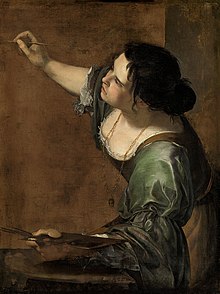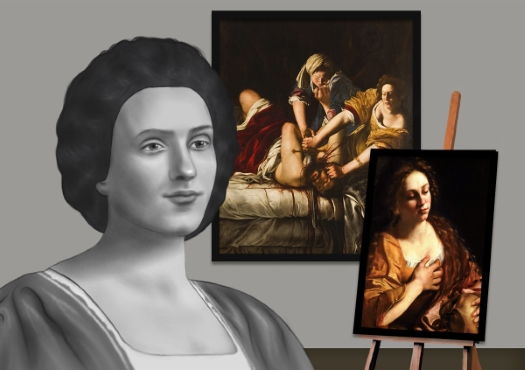Since the infamous Guerrilla girls Movement in 1985, the number of female artists in Metropolitan Museum of Art (MET) have gone up to 7 from 0. I have always believed that it takes a village to create an artist but to remember an artist if the artist is worth remembering, you need museums to find them worthy.
The most famous example of this is Vincent Van Gogh, who couldn’t sell a single painting in his lifetime and today, millennials would jump at the chance of buying hoodies that have a knockoff of his starry nights. God knows I’d kill for one of them! Vincent was still a post-impressionist painter much like what John Berger said in Ways of Seeing– “All publicity works upon anxiety.”
To remember artists, we seem to need a lot of pain behind their stories, something that Vincent’s life and work were full of. Every century picks its artist. But unfortunately, time is a tale told by men. Since 2017, post the #metoo movement, there has been a crack in the system. It is very little but just enough to give space to an Italian artist, a woman, a rape survivor and in her own words “ the spirit of Caesar in the soul of a woman” – Artemisia Gentileschi
The trial went on for seven months and she was put through every conceivable scrutiny (our revered courts still put women through this, mind you this was 400 years ago). The sheets were checked to prove she lost her virginity to rape, at one point, during her testimony to establish her truthfulness the authorities administered a primitive lie detector test in the form of torture by thumbscrews, a common practice at the time
Artemisia Gentileschi was a renaissance era painter. She was the contemporary of Micheal Angelo, Galileo as well as Leonardo Da Vinci. Her father Ozario Gentileschi was already an established painter and he noticed that out of all of his children, Artemisia was the only one who inherited a natural brilliance for art.

All historic accounts suggest that he was a strict father who believed in his daughter’s talent. At 17, Artemisia was subjected to rape by Ozario’s friend Agostino Tassi, also a celebrated artist and a close friend of the Pope at the time. She took him to court at a time when the onus was entirely on her to prove her story.
The trial went on for seven months and she was put through every conceivable scrutiny (our revered courts still put women through this, mind you this was 400 years ago). The sheets were checked to prove she lost her virginity to rape, at one point, during her testimony to establish her truthfulness the authorities administered a primitive lie detector test in the form of torture by thumbscrews, a common practice at the time.

In the testimony what stands out to me is that her chaperone was present and she screamed for help. Her chaperone was too scared to do anything against a man of that stature. It is also revealed that during that ordeal she grabbed a knife in an attempt to kill him, but failed.
The man was proven guilty but one must never underestimate religion’s alliance towards men who rape. Instead of serving his sentence he went scot free since he was friends with the Pope.

This is where her story begins. A note for the readers – I don’t mean to suggest that her pain created her genius. I maintain that she was a talented artist who would’ve created regardless, in fact, Sussana and the elders, her earliest know, signed work was created by her at 17. So her’s is not a “rape avenger” story.
Artemisia went on to create 57 paintings out of which 49 had female protagonists. She was the first woman to be admitted to the prestigious Accademia Delle Arti del Disegno (Academy of the Arts of Drawing). Her work was heavily inspired by Caravaggio and his dramatic realism which brings us to the painting titled Judith Slaying Holofernes.
It is rooted in the biblical story of a beautiful widow named Judith who lured a fascist army general into her tent and decapitated him with the help of her maid, hence bringing victory to her people.
This theme had been previously done by Caravaggio, a sculpture of it was also done by Donatello. But perhaps, no one has captured the essence of this subject as well as Artemisia. This is a painting that is a testament to her conscience as an artist, as well as a powerful reminder of female solidarity.
Artemisia was the only woman at that time portraying biblical stories, something that men had a monopoly over. However, when she decided to tackle these themes, she focuses on the power of the feminine. Her subject matter was raging women and for once, they were not unsure or fragile to be angry
The first version of the painting was done in 1612-13, around the same time as her rape. She channeled a lot of her discomfort into this intense piece. Later, Artemisia added an element to the painting – on the bracelet Judith wears is a depiction of Artemis – the Goddess who guarded her virginity carefully against those who tried to dishonour or rape her. Those that threatened this, met a violent end.
Artemisia was the only woman at that time portraying biblical stories, something that men had a monopoly over. However, when she decided to tackle these themes, she focuses on the power of the feminine. Her subject matter was raging women and for once, they were not unsure or fragile to be angry.
Artemisia was perhaps the first woman who through art, allowed women to flaunt their anger with pride. Let us compare Caravaggio’s expression of Judith to Gentileschi’s.
Here, Judith is younger, seems naïve and unsure. Most importantly, she seems like she is being led on by an older maid, once again reinforcing the idea that beauty and youth alone are incapable of doing something so gruesome without the corrupting assistance of an older maid.
In comparison to this, Artemisia has made both the characters equal partners in the crime. She was also the first woman and the first artist to give a crime scene medical accuracy. The way Holoforernes’s blood spills, stems from the direct influence of her friend in Florence, the man who coined parabolic trajectory i.e Galileo.
Also read: Watch: The Life And Times Of Amrita Sher-Gil
Speaking strictly about the painting, she has taken Caravaggio’s artistic drama a notch further – the colours are bolder, velvet red dominates in both the paintings. But Artemisia makes sure that blood gets to dominate her piece, making it an experience for the viewer, as she does away with the rules of aesthetics and decides to only stay true to the action that is taking place. Every viewer becomes a witness to the crime, or more accurately, Judith’s victory.

I maintain that Artemisia’s Judith is not a rape avenger fantasy, contrary to popular belief. It is also not a commentary that panders to retributive justice. It is what Artemisia hopes for us.
This is a woman who was not helped by her chaperon (an older woman) when she was being raped in the other room. This is a woman who tried to attack her assaulter with a knife and failed. To defeat patriarchy in its glory Artemisia knew that she alone was not enough.
I’m honoured to be a part of this generation that has once again found a way to make Artemisia’s work relevant and useful not only to the movement but also to the cultural idea of womanhood. Her work is a love letter to every woman and it reads “We’re as free from the male gaze as we were 400 years ago, so steady on, rage, rage, rage and look out for the Judiths in need, they could use a hand”
So her Judith is unafraid not because she knows she can win, she is unfazed because she knows what it takes to defeat patriarchy and its solidarity. It is no coincidence that the sword is the center of her portrait or that the hands of both her characters not only have striking vigour but also the force of determination.

Her Judith is a reminder of strength to all survivors and her servant is a request to all passive bystanders. Despite her brilliance, Artemisia was forgotten for 400 years. But in the 1970s, something changed. A generation of women decided they had enough with the underrepresentation of female artists.
Artemisia was back but movements are after all movements – fleeting in nature and always competing with time. Post 2017, there arose another movement, a movement desperately seeking to restructure and rebrand the conversation around rape culture. A generation of women rose once again, seeking permission to be angry, fed up with the tyranny of everyday Holofernes and hoping that the time has come to show the strength and solidarity that Artemisia once predicted for us.
Also read: Priya Ramani’s Victory Is A Hope For Many Who Said #MeToo
I’m honoured to be a part of this generation that has once again found a way to make Artemisia’s work relevant and useful not only to the movement but also to the cultural idea of womanhood. Her work is a love letter to every woman and it reads “We’re as free from the male gaze as we were 400 years ago, so steady on, rage, rage, rage and look out for the Judiths in need, they could use a hand”.
Smriti Bhoker is a struggling Urdu poet and writer who is studying sociology to understand the simple sexist things in life. When she is not procrastinating her work, she is making memes about it. Her biggest ambition in life is to earn a Ph.D. that contributes to the field of feminism while learning as many languages as possible to further complicate her ability to construct a decent sentence at social gatherings. You may find her on Instagram, Twitter and Soundcloud
Featured Image Source: The Art Story





wonderful your article is as amazing really great ….
Kerala taxi Tempo Traveller rental in Kerala